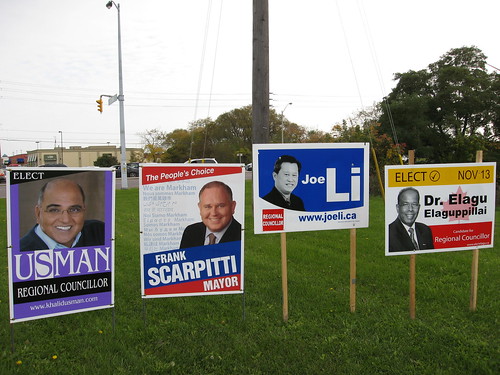
Green Party candidate Ellen Michelson has decided not to put up campaign signs in public spaces throughout her riding of Toronto Centre. “Public space is everyone’sâ€, she says, and she feels uncomfortable altering that space without any kind of agreement process. Instead she thinks that campaign volunteers who go door-to-door get the Green message across, along with information that can be found on the Internet.
Rami Tabello of illegalsigns.ca (who was profiled in the Summer/Fall issue of Spacing) disagrees completely with Michelson, however, calling her “completely misguided.” Tabello says the system for placing signs on the public road allowance is an important part of Toronto’s democracy and suggests that perhaps the Toronto Centre candidate just can’t afford the signs. Michelson says not placing signs on public property is part of the Green Party’s philosophy of “building consensus about our community.â€
Under the Toronto Municipal Code, election signs on public property can be posted as long as the person posting the signs pays a refundable $250 deposit to the city. This, partnered with very specific rules [PDF] on the placement of the signs, is already far too strict according to Tabello.
“Signs need monitoring,†Michelson counters. “People who post signs in public places can’t always monitor their condition.†Campaign signs placed on private property, also known as “bag signs”, are completely recyclable. Michelson even mentioned a case of carrying items to her campaign office in the upside-down bag of her own sign. And the wire part, she says, can be used for gardening.
photo by Lone Primate



10 comments
I grew up in a small city in Ontario where signs on public property of all types were forbidden: no election signs, no garage sale signs, no commercial signs, zip. The police actually enforced this – I can recall someone being told that a garage sale sign had to be moved if it was on the boulevard. I think this has relaxed a little, but that is the way it was maybe 20 years ago.
Although restrictive, it seemed to make some sense. The city was a much tidier environment. Toronto seems like a free-for-all with commercial ads for everything from politics to dog walking posted on every street corner. I wish we would question some of the long-standing ways this city is run.
I always feel a particular kind of contempt for candidates who have their signs in public spaces.
If you’ve got a candidate sign posted on private property, that says to me ‘someone in my neighbourhood, someone kind of like me, likes this candidate, maybe I should consider their positions.’ (Well, okay, more like ‘god, I can’t believe all the idiots in my riding are going to vote for Ken Dryden again.’)
A sign in a public space says to me ‘We didn’t have enough actual supporters who would let us put this crap in their yard, so we just dropped a few here.’
Sidewalks, parks and boulevards don’t vote, and I’m not interested in their opinion on who I should vote for.
Public spaces, parks and rights of way should not be used for commercial use and in MY defintion, that includes campaign signs. There is a parkette across the street from me… if a sign goes up in it, I’m taking it down and recycling it.
Jacquilynne: Nice to see a fellow York Centrer on this site. What do you have against Ken Dryden, apart from the fact he never responds to [my] correspondance, or his invisbility in the riding? Isn’t the fact that he’s a multi-talented hockey superstar/intellectual enough? 🙂
I believe Brampton has a law against election signs on public space. They also have laws against signs on private lawns as well (except real estate signs, election signs during a campaign and contractor’s signs while working on the site), they only really enforced that one when all the anti-P3 Hospital signs started to appear, angering local pols.
I was angry when the Liberals chose to parachute a star candidate into our riding because it was a ‘safe seat’. Several elections further along, and I’m still angry about the same thing. He’s not my MP — as you noted, he’s all but invisible within the riding. I feel like we have no representative at all.
I’m very, very glad to be moving to Parkdale-High Park in the next couple of years. A riding where it’s going to be a horse race between Peggy Nash and Gerard Kennedy instead of a walkover victory by a candidate who doesn’t appear to know where our riding is.
I haven’t seen one of the people running for election in Trinity-Spadina come to my door to talk with me on the upcoming election, although the Green Party has responded to each and every one of my emails.
Personally, I feel signs are a cop out for any representative who can’t be bothered with actually talking to people, to foster a better understanding of the issues they feel important.
A stupid placard is NOT going to gain my interest, or my vote!
I also live in York Centre, and asked myself the question, what has KD done for me? The answer Zip…. If you look at my lawn you will find a sign for another candidate…..
I don’t mind election signs, even on public property, however
the city should pass a by-law that requires all election signs be removed from public property within 24 hours of the polls closing. Otherwise the city can remove them, and bill the candidate for the removal, I think $50 per sign would be a reasonable fee.
Around election time in Paris, officials place a series of durable metal panels in front of the town halls of all of the arrondissements. Each candidate is given a few of the panels to cover with posters. Perhaps, though, this is more a solution for a city with next to no front lawns.
That said, I’m all for campaign signs in public spaces. They add to the city’s unfinished look and bring the election to the places that we use.
Rami Tabello, I assure you the Ellen Michelson campaign had money for public lawn signs. It was a matter of principle decided by the candidate and the EDA.
Wogster: The current bylaw (linked to in the post) gives candidates 72 hours after the close of the polls to remove their signs, with $25 per sign deducted from their deposit (plus potentially various other fines). I think that’s reasonable.